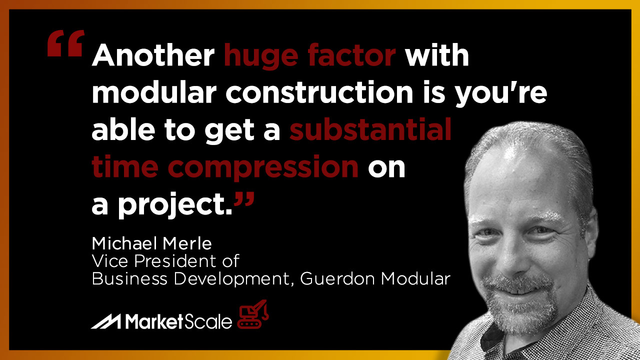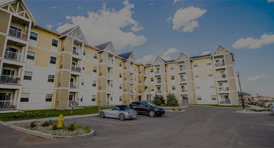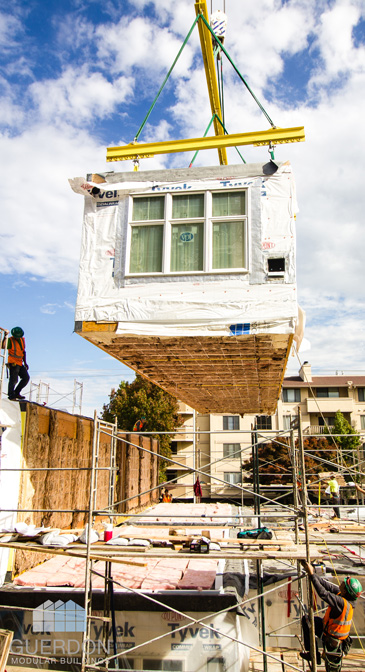LET’S MAKE YOUR JOB (AND YOUR LIFE) EASIER
Guerdon’s VP of Business Development, Michael Merle, was a featured guest on the Marketscale AEC podcast. Michael and the show’s host Elmer Guardado discussed some of the benefits, some of the common misconceptions, and why developers are embracing modular construction now, in a world where modular has become more efficient, more accepted and more practical than ever before.
Click this link or the image above to listen to the podcast. A 16 minute listen.
The following transcript has been simplified and reduced for brevity.
Elmer Guardado: Let’s start with defining modular construction for the uninitiated?
Michael Merle: Modular construction is essentially taking a large component of onsite construction and moving it offsite.
In our facility in Boise, Idaho, we have about one hundred fifty thousand square feet of covered manufacturing space where you are will see most of the same tradesman that you would on a typical site-built construction site. We have your framers, electricians, drywallers, final fit and finish, we have all the trades working in a controlled environment.
Similar to the type of production line most people would associate with an automobile factory. We have modules that we are moving down the line to various stations where various scopes of work are being completed. From there we ship these modules to the site where they are installed using a crane and structurally connected then finished out.
Elmer Guardado: There seems to be some obvious benefits here. I think the most important thing you mentioned was the control factor; when you don’t have to worry about all of these other variables, you obviously have a much more efficient process.
Outside of that obviousness is there something else that comes to mind when I ask you what are the benefits of modular construction and why would you go in that direction versus the traditional?
Michael Merle: [QUALITY] I think you keyed in on a major one of them, the controlled environment is absolutely one of the huge benefits. Everything we are building is in a jig, a 90-degree platform where we are able to laser level, square and true everything; you get a much higher level of finish, a much better precision fit when building in that environment. The level of finish, at the end of the day, is substantially better.
[SPEED] Another huge factor when considering modular construction is your ability to get a substantial time compression on a project. We build in various sub sets of the industry; hospitality projects, multifamily projects, student housing, workforce housing, etc. For hospitality and student housing in particular, timing becomes a very critical issue. On a typical hospitality project, about one hundred-fifty rooms, you can save six to eight months in the overall project cycle. While we are building in the factory, the site is getting prepped; all of the civil work is underway, everything is getting ready so that as soon as the level one is ready we bring in the modules to stack.
For a hotel, when you open the door, for all intents and purposes, that room is done; the beds are in, wallpaper is on the wall, the artwork is hanging on the wall, they are delivered with the TV’s and the lamps and other room essentials inside. All your mechanical, electrical, and plumbing still must be done in the corridors but the portion in the rooms, for all intents and purposes is complete.
We are building the hotel rooms while the site is getting ready, we show up and get them crane set in a matter of a week or ten days and then all that is left is to finish up the common areas. In doing so, on an average hotel, you can save six to eight months.
We just opened one in LA which was a very large project, 354-keys, on which they saved over a year of what they would have had if they had built that using typical construction methodology.
Elmer Guardado: So Michael, I do want to talk about some of the misnomers, I think there are two really interesting ones that really stick out to me. The first one is that modular is being embraced right now but it has been around for a while, right?
Michael Merle: It absolutely has. While it’s been fairly recent in commercial construction, particularly in North America, our organization has been on the leading edge for the West Coast. We’ve been doing strictly commercial modular for about the last twenty years. It has been around and very much embraced in Asia and in Europe, but North America is a little bit behind the eight ball, but definitely catching up.
Elmer Guardado: Is there something that you think is attributing to people embracing it now?
Michael Merle: There are a number of things I believe are driving the acceptance in the marketplace. Construction costs continue to go up in virtually every market which is putting modular construction more on par in your high barrier markets; in some cases you actually have a substantial cost savings in addition to the benefits of quality and the compression of time that you are gaining.
The increase in the shortage of labor that we are seeing in the trades is another. If you look back at the 2008-09 recession hitting the construction industry, a lot of the trades left the marketplace at that point and a lot of those folks have not come back. The ability to have those scopes of work completed off-site, gives developers a fighting chance. Again, I’m talking specifically about a lot of these high barrier, high cost markets that are really feeling the pain of the shortage of labor. We’re able to provide a solution where you can get a lot more done with a lot smaller crew. On these big commercial buildings typically requiring an MEP crew of 15-20, if you take a substantial amount of the scope off-site, you’re able to come in with a crew of three to five and get done what historically has taken a much larger number of folks to complete.
Elmer Guardado: That is incredible. It actually leads us into the second misnomer that I wanted to touch on, the misconception that modular construction equals an inferior product.
Michael Merle: If you step back, and again I’m speaking from a North American perspective because it has been around longer and much more broadly accepted in other parts of the world but when you step back twenty or thirty years you see the grandfather to what we’re doing today are the mobile homes and the doublewides. This is the catalyst of the misnomer or misunderstanding of “ok, well, if you’re talking modular construction, you’re looking at pulling trailer houses up, pulling the wheels off and stacking them up.” It absolutely is not the case. In every area that we build we are held to the same construction code as you would if you were doing site built. We are doing a tremendous amount work in California with all the seismic code and we must build to the same exact code as you would locally.
These modules that we are building, they actually have to be over engineered, they have to be over built. In addition to moving through the production line, we are trucking these units up to fifteen hundred miles over the road, from there they are craned and swung through the air, if they don’t have the structural integrity required, you would wind up with problems like drywall cracking, problems with your mechanical and electrical and plumbing potentially breaking. Issues would arise if you don’t have the level of precision that we’re talking about before. If you’re not able to put everything on the ninety-degree jigs and that type of thing in the factory you’re going to have problems stacking these three, four, or five stories. We really do build them to a much higher level of quality, level of precision and level of finish then you are even able to do in a site built component.
Elmer Guardado: Michael, the last thing I want to ask you about is the heavily front-loaded process. The bulk of the work is going to be done in the front end so what are some of the tips you have for someone trying to do this for the first time successfully? Or what are some of the imported ‘to knows’ in the pre-production phases?
Michael Merle: Great question. Modular construction is not going to be a solution, it is not going to be a fit for every type of build out there. You have to do your due diligence upfront. You need to understand what that process looks like. There are a couple pieces of advice that I would give.
First and foremost, you need to decide early on whether or not the project is a candidate for modular construction. If it is, you need to engage your architect, you need to engage your GC, you need to engage your lenders, you need to engage all your consultants because, as you mentioned, it is very front loaded. The design work that must happen prior to production, because it moves so quickly, you need to spend four or five months on the frontend going through the design; you’ve got to make all of your decisions early and then from there it will go very quickly. When cycling a 150-key hotel, whether it is a Fairfield Inn & Suites or a Courtyard or a Hampton Inn or Hyatt Place, we will move one of those through our production facility in a matter of six weeks from start to finish so you’ve got to have all of the decisions made early on. You’ve got to procure early so everything is sitting on the dock when you start production. By the time you are ready to hit the go button it moves very, very quickly.
There is a growing stable of architects, lenders, GCs, consultants, brands, and developers that are now becoming familiar with this because proof of concept has been established. This is something that’s been happening for a long time but has just now, really over the course of the last few years, has become generally accepted into the marketplace. The more folks that have the experience and the successful projects, the easier it is to continue to move forward as we have a broad base of support and folks that really understand the methodology.
Elmer Guardado: That is super exciting just to think about. It does feel relatively new because of how it’s being embraced but like you just said, it’s not a question of ‘if’ and ‘how’ anymore it is more of a ‘when’ and ‘what’ kind of a situation. It is cool and exciting that we have this proof of concept already and there’s plenty of successful examples out there. Michael, it was an absolute pleasure, thank you so much for your time and thank you for being on our show.










